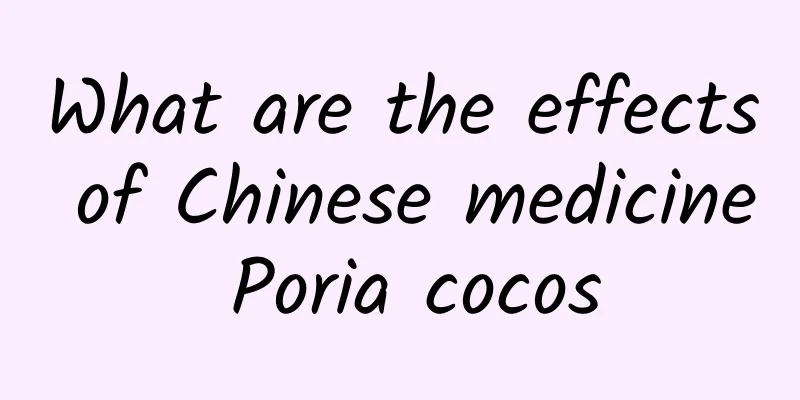What are the effects of Chinese medicine Poria cocos

|
Poria cocos is a traditional Chinese medicine, and its preventive effect on many diseases is very extensive. In daily life, some Chinese medicine practitioners will use medicinal materials such as Poria cocos. So what are the effects of the traditional Chinese medicine Poria cocos? What nutritional effects does it have on the human body? We must have a correct understanding of the important Poria cocos. If you pay attention to Poria cocos, you need to consider its specific effects. The following will introduce the effects of the traditional Chinese medicine Poria cocos. Spleen deficiency diarrhea leucorrhea Poria can both strengthen the spleen and eliminate dampness, and its health care effect is relatively ideal. It is used in combination with Codonopsis pilosula (a common Chinese medicine), Atractylodes macrocephala, Chinese yam, etc. to treat diarrhea, leucorrhea, and other minor ailments caused by spleen deficiency and dysfunction. These minor ailments are common, and the application of Poria can take both the symptoms and the root cause into consideration, with a relatively ideal effect. It is often used in combination with Codonopsis pilosula (a common Chinese medicine), Atractylodes macrocephala, Chinese yam, etc. It can be used as an auxiliary medicine to nourish the lungs and spleen, and to treat qi deficiency. Phlegm and cough Phlegm and dampness enter the meridians, causing sore shoulders and back. Poria can not only promote diuresis and eliminate dampness, but also has a spleen-strengthening effect. It has a therapeutic effect on spleen deficiency, which is unable to transport and transform water and dampness. If water and dampness cannot be transported and transformed, they will accumulate and turn into phlegm and fluid. The therapeutic effect is ideal. Pinellia and tangerine peel can be used together, or they can be used together with cinnamon twig and Atractylodes macrocephala. It can be used together with Pinellia ternata and Citrus aurantium to treat phlegm and dampness entering the collaterals and infiltrating the meridians, causing shoulder and back pain. Palpitations, insomnia, etc. Poria can nourish the heart and soothe the mind, so it can be used for problems such as restlessness and anxiety, palpitations, insomnia, etc. It is often used in combination with ginseng, polygala, and spinach seed. The effect of using them together for insomnia and palpitations is relatively ideal. Anti-cancer It is commonly used clinically to treat esophageal cancer, gastric cancer, liver cancer, common diseases such as nasopharyngeal cancer, tongue cancer, breast cancer, bladder cancer, and lung cancer, which impose a heavy burden on the family or the human body. Among cancers such as ulcerative melanoma, those who are caused by spleen deficiency and dampness, internal retention of phlegm and fluid, and damp-heat congestion have more serious conditions. Difficulty urinating, edema, etc. Poria cocos can promote diuresis and eliminate dampness, and its medicinal properties are mild without being particularly irritating. It can promote diuresis without damaging the body's vital energy, making it an important medicine for promoting diuresis and eliminating dampness, with powerful effects. It can be used for any symptoms of difficult urination and water stagnation with obvious characteristics, regardless of whether it is caused by cold and dampness, dampness and heat, or spleen deficiency and dampness. If the patient tends to be cold and damp, it can be used together with cinnamon twig, white atractylodes, etc.; if the patient tends to be damp and hot, it can be used together with Poria cocos, Alisma orientalis, etc., and multiple Chinese medicines can be used together; if the patient has spleen deficiency, it can be used together with Codonopsis pilosula, Astragalus membranaceus, white atractylodes, etc., and multiple Chinese medicines can be used together; if the patient has deficiency and cold, it can also be used together with aconite, white atractylodes, etc. What are the effects of the traditional Chinese medicine Poria cocos? The above article has introduced it to you in detail. In fact, it includes the prevention of many of the diseases mentioned above. For example, it can treat patients' coughs, fight cancer, and help relieve symptoms such as edema. The traditional Chinese medicine Poria cocos has great effects and is especially suitable for many people. However, the Chinese medicine Poria cocos also needs to be used in combination with some other Chinese medicines. |
<<: What are the effects of the Chinese medicine Cistanche deserticola?
>>: What are the effects of the Chinese herbal medicine Cistanche deserticola?
Recommend
Where do the elements on the periodic table come from?
The elements' journey began in the first mome...
Is acupuncture good for tics?
Tourette syndrome is a disease symptom that often...
The efficacy and function of Feilailan
I don’t know if you are familiar with Feilailan a...
What are the effects of wild Polygonum multiflorum
The nutritional and health benefits of wild Polyg...
Why can't we see atoms with an optical microscope?
Through an optical microscope, we can see bacteri...
Why do the things we longed to grab on Double Eleven not seem so attractive after we get them?
Review expert: Li Xianhong, National Level 2 Psyc...
The role of yew
People who eat grains and cereals will get sick. ...
Is this pop-up window weird? Beware of "logic bombs"!
1. Introduction Xiaobai: Dadongdong, can you help...
Sweet autumn starts with chestnuts, and this "hybrid" is the most unique way to enjoy chestnuts!
Author: Fluent What is the strongest smell on the...
Not just lung cancer! Why is it so hard to quit smoking?
Have you ever had such an experience? I finally w...
Benefits and Uses of Elderberry Leaves
Elderberry leaf is a kind of traditional Chinese ...
What are the medicinal values of lotus incense?
I believe everyone is familiar with lotus leaves....
The efficacy and function of Yahonglong
Many people are not very clear about the effects ...
The Arctic isn't too cold?
Arctic Earth's North The total area exceeds 2...
AI is invited to give its "acceptance speech"! Has the new era of science empowered by AI arrived?
It was somewhat unexpected that the 2024 Nobel Pr...









